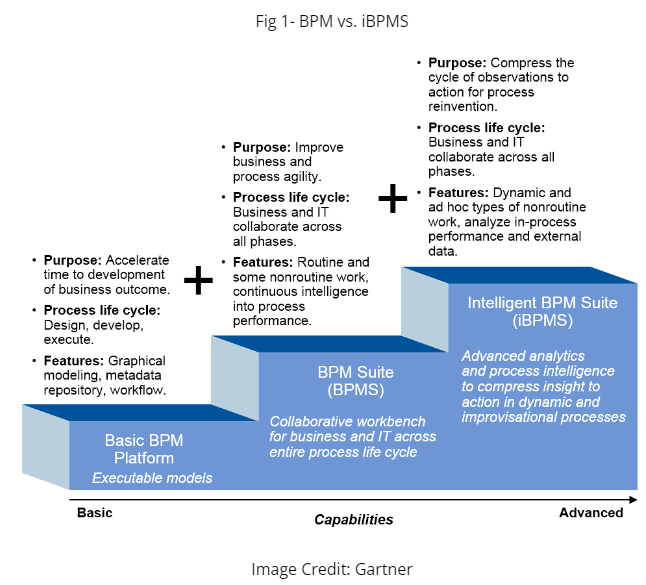As businesses grow and evolve, the need for efficient and effective automation tools increases. Business Process Automation (BPA) software provides a comprehensive platform for automating and streamlining business processes, thereby improving productivity, reducing costs, and enhancing the overall employee or customer experience.
Today, it's important to take a closer look at the essential capabilities of BPA software that will help businesses stay ahead of the curve. In this blog post, we'll explore the seven crucial capabilities of BPA software that are critical for 2023. By understanding these capabilities, businesses can make informed decisions about which BPA software solutions best suit their needs and ensure they remain competitive.
Artificial Intelligence
Artificial Intelligence (AI) is becoming a more critical capability of Business Process Automation (BPA) software. AI allows businesses to automate complex tasks using natural language processing (NLP) and machine learning (ML) algorithms. By incorporating AI into BPA software, companies can improve processes over time. It can also become a key technology for your Continuous Improvement (CI) program.
As AI technology continues to evolve, its importance in BPA software will only increase, making it a critical capability for businesses to consider when selecting BPA software solutions.
Intelligent Business Process Management Suites (iBPMS)
iBPMS suite is essential to any Business Process Automation Software solution because it provides businesses with various tools to support all process automation needs. It is a more robust and capable version of the BPM suite. We captured the key difference between BPM Suite and an iBPMS in our post “A quick start guide to business process management for the enterprise”. In summary, the Gartner image below captures the essence of differences between BPM and iBPMS.

It includes intelligence and support for industry and organizational-specific processes, actionable real-time insights to increase the agility and scalability of business operations, and the ability to leverage analytics from cloud computing, business activity monitoring, and AI.
It makes the BPA software solution an integrated platform for the design, execution, monitoring, and optimizing of business processes. iBPMS suites create an agile, automated business environment that automates the execution of procedures and tasks by leveraging AI-powered automation capabilities.
Robotic Process Automation (RPA)
Robotic process automation (RPA) is software that automates manual, repetitive, and rule-based tasks. It frees up human workers from functions such as data entry, invoice processing, and customer service, and they can even complete these tasks faster than humans.
RPA can also be used to automate complex processes that span multiple systems because it can be easily scaled up or down depending on business needs, making it easy to manage spikes in demand.
For one large insurance cooperative, McKinsey found that robotic process automation allowed 81 percent of staff members to take on proactive account management positions—reducing excess queue procedures affecting 2,500 high-risk accounts daily.
See how AgilePoint takes RPA to new heights.
Packaged Business Capabilities
Packaged Business Capabilities are a collection of software solutions that address specific business needs. These solutions can be purchased as a bundle, or they can be customized to fit the needs of a business organization.
Packaged solutions are typically delivered as part of an integrated suite of software, which may include additional modules such as sales force automation (SFA), supply chain management (SCM), project portfolio management (PPM) and others. This makes them an important part of any BPA solution because they provide the ability for companies to tap into pre-built applications that have been designed specifically for their industry needs.
Event-Driven Software Architecture
Event-driven software architecture is a design pattern that allows for real-time responses to changes in data. It is essential because it allows for real-time communication between IT solutions, enabling them to respond quickly to changes or events. For example, when an item is placed in a shopping cart on an e-commerce website, this event can trigger a response from the system.
EDA enables an organization to manage events and their associated data effectively. Business organizations can use BPA software solutions with EDA to handle things like sentinel events that trigger automated responses, event notifications for end users or systems, and real-time data analytics. It is essential for distributed systems, as it allows for the efficient communication of events between services.
Integration Platform as a Service (iPaaS)
Integration platform as a service (iPaaS) is an essential business capability. It can seamlessly connect applications and workflows across disparate systems, saving time and effort by eliminating the need to develop and maintain multiple integration frameworks.
Typically, an iPaaS platform provides pre-built connectors, business rules or maps, and integration services that make creating applications with enterprise capabilities simple. With iPaaS, business organizations can integrate multiple applications and services into a single platform, automate the integration of applications and services, or automate data flow between applications and services such as customer relationship management (CRM), enterprise resource planning (ERP), and human capital management software solutions.
AgilePoint's product head captured his thoughts about the BPM platform vs. iPaaS in our blog post "Business Process Management (BPM) Vs. Orchestration Platform – The Big Picture."
Business Process Management (BPM)
Business Process Management (BPM) is an approach to managing and optimizing business processes. It involves automating the execution of processes and tasks and monitoring and analyzing processes to identify areas for improvement.
Business process automation software provides a comprehensive platform for implementing BPM by implementing a consistent, automated process for routine transactions and human interactions. BPM can reduce the business's operational costs by decreasing waste and rework and increasing efficiency. It can also help with compliance efforts by centralizing data collection and analysis.
Bonus: Low-Code/No-Code Tools
BPA software solutions handle cross-functional automation use uses, so having the right capabilities is essential. Low-code/no-code tools provide a platform for quickly developing applications without coding. These tools automate the development process and reduce time to market, allowing users to customize applications with minimal coding.
By using low-code/no-code tools, businesses can create custom apps faster than ever before—with much less effort than traditional approaches require—so they can focus on delivering value through innovation instead of spending valuable resources on building custom software solutions from scratch.
Key Takeaway
To automate your business processes at scale, you need a flexible, easy—to—use platform—and powerful enough with all the essential capabilities mentioned above.
AgilePoint is a
complete intelligent process automation platform for the enterprise, with all the technology needed to achieve hyper-automation, including iBPMS, Packaged Business Capabilities, EDA, iPaaS, BPM, and Low-Code/No-Code Tools.
With AgilePoint, businesses can build robust business applications faster than ever before—and all without the need for coding! AgilePoint
integrates
with popular business software and apps, giving users greater functionality without adding complexity to their day.
Want to get started? Book a
personalized demo today!
Are you ready to reengineer your business
automation processes?

A modern process automation and orchestration platform that enables you to open up and seize new business opportunities, supercharge innovation, unlock new levels of efficiency and productivity, and deliver the experiences that help you win.
Follow Us
Platform

Automate business processes and workflows at scale. AgilePoint helps enterprises democratize and accelerate digital transformation, reduce technical debt and future-proof ROI.
Resources
© 2023 AgilePoint. All rights reserved.



